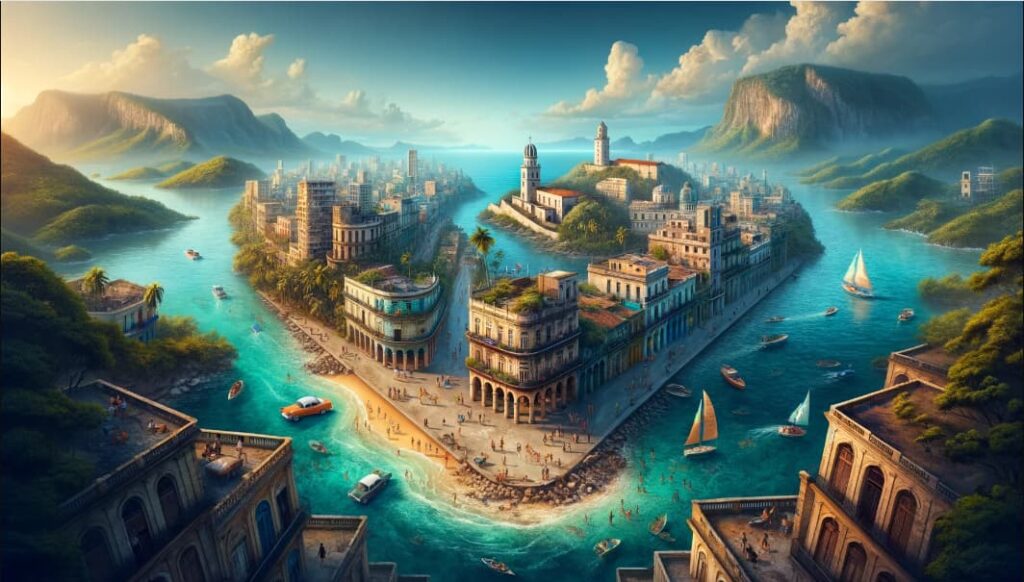Cuba
What is Cuba Known For? Ready for a Caribbean adventure
What is Cuba Known For? Cuba, a nation with a pulsating heart, stands out in the Caribbean for its distinctive blend of vibrant culture, profound history, and breathtaking landscapes.
This island, brimming with life, invites travelers to explore its many facets, from rhythmic music that moves the soul to lush, verdant valleys that captivate the eye.
Ready to dive into the essence of Cuba and discover what makes it a magnet for wanderlust spirits around the globe?
Section 1: The Vibrant Pulse of Cuban Culture
Cuban culture is a vivid tapestry woven with the threads of diverse influences, rich history, and a resilient spirit. At its heart are the music and art that not only define the Cuban experience but also resonate around the world. Delving deeper:
Section 1.1: Music and Dance
Cuban music is an intricate blend of African rhythms, Spanish melodies, and Caribbean zest, creating a sound that is both unique and universally appealing.
The island’s musical genres, like Son Cubano, Salsa, Mambo, Cha-Cha-Chá, and Rumba, have left an indelible mark on the global music scene.
These genres encapsulate the island’s complex history, its struggles, joys, and the indomitable spirit of its people.
Son Cubano: The soul of Cuban music, combining Spanish guitar with African rhythms, it’s the precursor to Salsa and has influenced jazz and other Caribbean music forms.
Salsa: Evolved from earlier Cuban music forms, Salsa is synonymous with Cuban dance, characterized by vibrant, energetic movements and rhythms.
Mambo: Originating in the 1930s, Mambo captures a fusion of swing and Cuban dance music, leading to a dance craze in the United States and beyond.
Cuban dance is as integral to the culture as the music itself, with each dance telling a story, expressing emotion, and celebrating life.
From the sensual Rumba, born from African slaves’ music and dance, to the elegant Danzón and the energetic Casino (Cuban Salsa), dance is a way of life, a mode of expression, and a symbol of Cuba’s cultural heritage.
1.2: Art and Literature
Cuban art and literature reflect the island’s rich tapestry of history and culture, bearing witness to its colonial past, revolutionary fervor, and the contemporary challenges and triumphs of its people.
Visual Arts: Cuban art is a dynamic blend of African, European, and North American influences, evident in the vibrant street art of Havana, the politically charged murals, and the innovative works of contemporary artists like Wilfredo Lam and José Fuster. Cuban art tells the story of the nation’s identity, resilience, and creativity.
Literature: Cuban literature offers profound insights into the Cuban psyche, from the national hero José Martí’s poetry and essays.
Which were instrumental in the fight for independence, to the magical realism of Alejo Carpentier, and the poignant narratives of modern authors like Leonardo Padura.
These works explore themes of identity, freedom, and the complexities of Cuban life.
Cultural Festivals: Cuba’s cultural festivals, such as the Havana Biennial for Art and the International Ballet Festival, are a testament to the island’s rich artistic heritage and its ongoing influence on the global stage.
These festivals attract artists, musicians, and cultural enthusiasts from around the world, fostering a dialogue that transcends political and social boundaries.
Influence and Legacy: The global impact of Cuban culture is undeniable, with Cuban music influencing genres like jazz, salsa, and even hip-hop.
Cuban art and literature continue to inspire a worldwide audience, showcasing the universal themes of struggle, joy, and the enduring spirit of humanity.
Cuban culture, with its music, dance, art, and literature, is a celebration of life’s complexity, beauty, and resilience. It invites us to explore, understand, and appreciate the depth of human experience, making it an essential chapter in the story of world culture.
Section 2: Iconic Cuban Attractions
![]()
Cuba beckons with its vibrant tapestry of history, culture, and natural beauty, offering travelers a journey through time and a deep dive into the island’s soul.
Each attraction, from the cobbled streets of Old Havana to the serene beaches of Varadero, tells a unique story of the Cuban spirit.
2.1: UNESCO World Heritage Sites
The island is dotted with sites that hold universal value, each a testament to Cuba’s rich heritage and natural splendor.
Old Havana and its Fortification System: Wander through the historic heart of Havana, where every building and plaza whispers tales of the past. Enhance your exploration with a detailed guide to Old Havana’s architectural wonders and hidden gems [Affiliate Link].
Trinidad and the Valle de los Ingenios: Step back in time in Trinidad, where the echoes of the sugar trade linger in the air. Discover the stories of wealth and human toil with an expertly written history book on Trinidad and the sugar industry [Affiliate Link].
Vinales Valley: Immerse yourself in the breathtaking landscapes of Viñales, a living museum of rural life in Cuba. Capture the beauty with top-rated photography gear recommended for nature enthusiasts [Affiliate Link].
2.2: Beaches and Natural Landscapes
From the famed shores of Varadero to the untouched beauty of Playa Paraíso, Cuba’s beaches are a paradise waiting to be discovered.
Varadero Beach: Experience the ultimate beach getaway in Varadero, where crystal-clear waters meet endless sands. Find the perfect beach essentials, from eco-friendly sunscreens to stylish swimwear, for your Cuban beach adventure [Affiliate Link].
Playa Paraíso in Cayo Largo: Seek solace in the serene ambiance of Playa Paraíso, a haven of tranquility. Equip yourself with the latest in snorkeling gear to explore the vibrant underwater life, available through our recommended outdoor adventure retailer [Affiliate Link].
Baracoa’s Natural Wonders: Venture into the heart of Cuba’s first Spanish settlement, surrounded by lush landscapes and the mysterious El Yunque. Prepare for your trek with durable hiking boots and gear suited for the tropical climate, handpicked by our travel experts [Affiliate Link].
2.3. Cuban Architecture: A Reflection of History
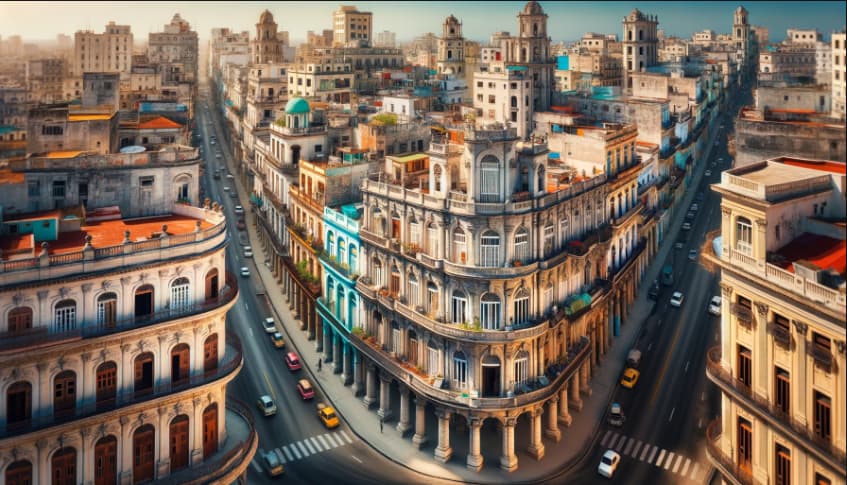
Cuba’s buildings are more than just structures; they are narratives in stone and mortar, reflecting the island’s multicultural layers.
Havana’s Art Deco Buildings: Marvel at Havana’s lesser-known Art Deco treasures with a specialized architectural tour guidebook, showcasing the best of the city’s 20th-century elegance [Affiliate Link].
Cienfuegos’ French Charm: Explore the “Pearl of the South” with its unique French flair. Dive into the history and architectural beauty of Cienfuegos with a comprehensive cultural guide [Affiliate Link].
2.4. Revolution and Beyond: Sites of Historical Significance
The spirit of the Cuban Revolution is palpable across the island, with numerous sites marking key moments in Cuba’s modern history.
Santa Clara’s Che Guevara Mausoleum: Pay homage to Che Guevara and his comrades at this solemn memorial. Understand the man behind the myth with critically acclaimed biographies of Che Guevara, offering insights into his life and legacy [Affiliate Link].
Bay of Pigs (Playa Girón): Reflect on the pivotal Bay of Pigs invasion at the very site where history unfolded. Explore the event in depth with a documentary film that provides a comprehensive overview of this turning point in Cuban-American relations [Affiliate Link].
Cuba’s myriad attractions, from its World Heritage Sites to its revolutionary landmarks, invite travelers to explore, learn, and be inspired.
Each visit not only offers a glimpse into Cuba’s past and present but also weaves a personal connection to the island’s enduring allure.
With the right guidebooks, gear, and insights [Affiliate Links], your journey through Cuba will be an unforgettable tapestry of experiences, each more enriching than the last.
Section 3: A Taste of Cuba
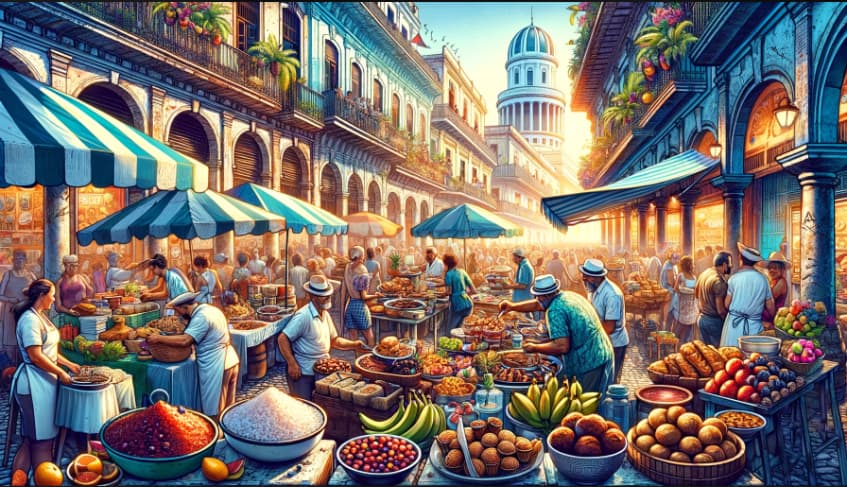
Cuba’s culinary landscape is as diverse and vibrant as its culture, offering flavors that are a testament to the island’s rich history and the melting pot of influences that have shaped it.
From the aromatic Cuban coffee to the iconic rum and world-renowned cigars, each element tells a story of tradition, craftsmanship, and the Cuban way of life.
3.1: Cuban Cuisine
Cuban cuisine is a flavorful fusion of Spanish, African, and Caribbean influences, creating a unique gastronomic experience.
Dishes like ropa vieja, a succulent shredded beef stew, and the hearty Moros y Cristianos, a blend of black beans and rice, reflect the island’s history and its blend of cultures.
Explore Cuban Flavors: Dive into the heart of Cuban culinary traditions with a cookbook that brings the island’s most beloved dishes to your kitchen. From savory to sweet, these recipes are curated to offer an authentic taste of Cuba [Affiliate Link].
3.2: Cuban Coffee, Rum, and Cigars
Cuba’s coffee, rum, and cigars are celebrated worldwide, each embodying the essence of the Cuban spirit and its rich agricultural heritage.
Cuban Coffee: Start your mornings with the bold and rich flavors of Cuban coffee. Discover the best blends and learn the art of making the perfect Cuban espresso with premium coffee beans sourced directly from the island’s lush mountains [Affiliate Link].
Cuban Rum: Savor the smooth, complex profiles of Cuban rum, a staple of the island’s culture and economy. Explore a selection of the finest rums, perfect for sipping or crafting classic Cuban cocktails like the Mojito and Daiquiri [Affiliate Link].
Cuban Cigars: Experience the luxury of a hand-rolled Cuban cigar, a symbol of craftsmanship and tradition. Whether you’re a connoisseur or curious about the allure of cigars, find the perfect sampler set to appreciate the art of cigar smoking [Affiliate Link].
Section 4: The Spirit of Cuban History
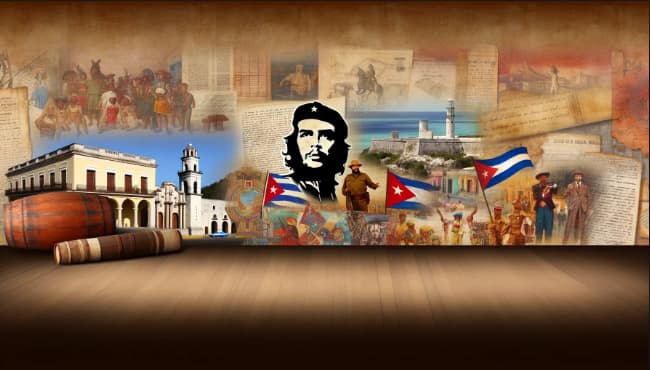
Cuba’s history is a tapestry of revolutionary fervor, colonial legacies, and the enduring spirit of its people. From the battlegrounds of the Cuban Revolution to the colonial architecture that adorns its cities, every corner of the island tells a part of Cuba’s storied past.
4.1: The Cuban Revolution and Its Icons
The Cuban Revolution marks a defining moment in the island’s history, shaping its political, social, and cultural landscape.
Figures like Che Guevara and Fidel Castro emerged as symbols of the revolution, their legacies etched into the fabric of Cuban society.
Discover the Revolution: Delve into the history of the Cuban Revolution with a comprehensive book that explores the events, ideologies, and figures that shaped this pivotal period.
Gain insights into the complexities of Cuba’s quest for independence and its impact on the world stage [Affiliate Link].
4.2: Colonial Heritage and Architecture
Cuba’s colonial heritage is visible in its stunning architecture, from the Spanish forts that guard its coasts to the grand colonial mansions that line its streets.
This architectural diversity offers a glimpse into the island’s multifaceted history and the various cultures that have influenced it.
Architectural Wonders: Embark on a journey through Cuba’s architectural marvels with a beautifully illustrated guide. From Havana’s colorful facades to Trinidad’s cobblestone streets, discover the stories behind the buildings that define Cuba’s colonial past [Affiliate Link].
Cuba’s cuisine and history are integral to understanding the island’s identity and allure. From the rich flavors of its food to the revolutionary spirit that shapes its narrative, Cuba offers a journey through time and taste.
With each dish, sip, and step through its historic streets, you’re invited to experience the essence of Cuba, a land of passion, resilience, and unparalleled beauty.
As you plan your culinary exploration or historical journey through Cuba, let these curated selections [Affiliate Links] guide you to the heart of the Cuban experience.
Section 5: Cuba’s Natural Wonders
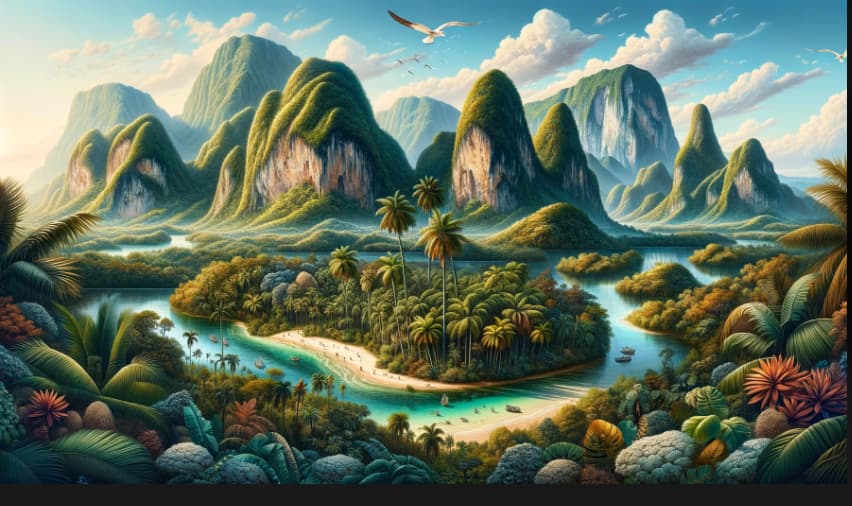
Cuba’s natural landscapes are as captivating and diverse as its culture, offering everything from lush mountain ranges to vibrant coral reefs.
This rich biodiversity not only provides stunning vistas but also habitats for unique wildlife, making Cuba a prime destination for nature lovers and eco-tourists.
5.1: Flora and Fauna
Cuba’s ecosystems are teeming with life, hosting an array of endemic species that cannot be found anywhere else in the world.
The island’s national bird, the Cuban trogon or “tocororo,” with its vibrant plumage, mirrors the colors of the Cuban flag, symbolizing the island’s natural beauty and spirit.
Discover Cuba’s Wildlife: Embark on a journey through Cuba’s natural habitats with a comprehensive wildlife guide. Perfect for birdwatchers and nature enthusiasts, this guide details the island’s unique biodiversity [Affiliate Link].
5.2: Outdoor Adventures
From the verdant trails of the Sierra Maestra to the underwater wonders of Jardines de la Reina, Cuba offers a plethora of outdoor adventures.
Whether you’re hiking, diving, or simply exploring, Cuba’s landscapes provide a backdrop for unforgettable experiences.
Gear Up for Adventure: Prepare for your Cuban outdoor adventure with the best gear for hiking, snorkeling, and more. From durable footwear to top-notch snorkeling equipment, find everything you need for your journey [Affiliate Link].
Section 6: Planning Your Cuban Adventure
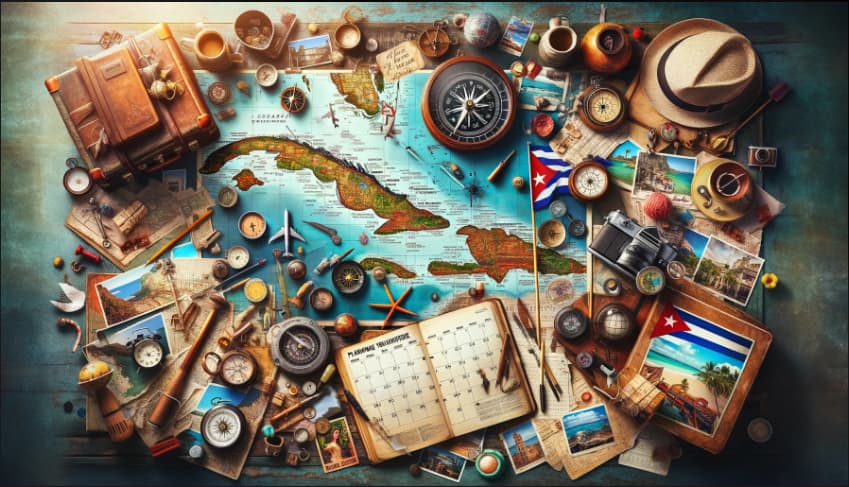
A trip to Cuba is more than a vacation; it’s an immersive experience in a land of rich history, vibrant culture, and breathtaking natural beauty. To ensure a seamless journey, it’s essential to have the right information and resources at your fingertips.
6.1: Travel Tips and Essentials
Traveling to Cuba requires some planning, from understanding visa requirements to knowing what to pack. Staying informed about travel regulations and having the right accessories can make all the difference in your travel experience.
Cuba Travel Guide: Equip yourself with a comprehensive travel guide to Cuba, offering insider tips, essential information, and practical advice for navigating the island. This guide is an indispensable resource for any traveler [Affiliate Link].
6.2: Best Times to Visit and Cultural Festivals
Cuba is alive with cultural festivals and events throughout the year, offering travelers a glimpse into its rich traditions and celebrations.
Timing your visit to coincide with these festivals can provide a deeper understanding of Cuban culture and an opportunity to participate in unique local experiences.
Experience Cuban Festivals: Delve into the heart of Cuba’s cultural festivities with a guide to the island’s most vibrant events.
From the electrifying Carnival in Santiago to the internationally acclaimed Havana Jazz Festival, discover the best times to experience Cuba’s rich cultural tapestry [Affiliate Link].
Cuba’s natural wonders and thoughtful travel planning are integral to experiencing the full spectrum of what the island has to offer.
From its unique ecosystems and outdoor adventures to practical travel tips and cultural insights, every aspect of Cuba invites exploration and discovery.
With the right guides and gear [Affiliate Links], your Cuban adventure will not only be enriching but also a journey that connects you deeply with the natural and cultural heartbeat of this extraordinary island.
Conclusion:
Exploring Cuba is more than just a journey through its vibrant streets and picturesque landscapes; it’s an immersive experience of a culture rich with history, art, and an indomitable spirit.
From the rhythmic beats of its music to the aromatic essence of its cuisine, every aspect of Cuban life invites you to delve deeper and connect with its soul.
As you plan your adventure, remember that the true essence of Cuba lies not only in its iconic attractions but also in the everyday moments and interactions with its welcoming people.
With the right preparation and a spirit of curiosity [Affiliate Links], your Cuban voyage will be a tapestry of unforgettable memories.
Are you ready to embrace the vibrant heart of the Caribbean and create your own Cuban story?
Recent Posts
- What to do in Cuba: Discover the Best of Cuba
- Cuban Dishes: A Culinary Journey
- Strawberry Tres Leches Cake: A Sweet and Fruity Dessert
- What Language Does Cuba Speak?

